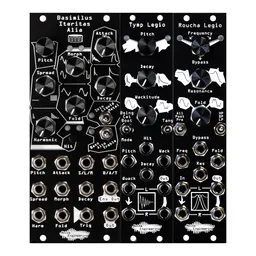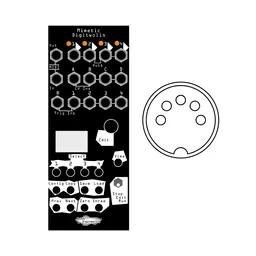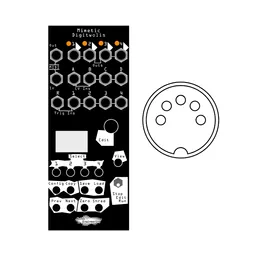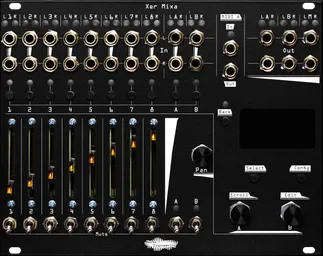We have put a lot of modules out here at NE over the years. I am pretty sure the total is over 50 at this point. Even after all this time, every module release is different, and some are far easier than others. And some…some are problem children that span almost a decade in development.
This is the story of such a product.

A long time ago, in a galaxy far, far away, Stephen said, I’ll make a mixer
The story of Xer Mixer starts way back before you heard of Noise Engineering. Long-time readers may know that NE started as a hobby for Stephen. Back in those early days, he had a spare bedroom where he let the parts run rampant and Kris had no idea what he was doing. Ataraxic Translatron was the first module that he designed, and that was followed by Basimilus Iteritas and a few other fun ones that you may know, but the origin story of Xer Mixa started at this time too. Back then, it had a different name (Mictic Xerester) and a very different feature set: 4 mono inputs with mutes.
This concept persisted for a while in various forms. The version that lasted the longest was called Xerest Numeri. For years, at NAMM, we ran the case on a version XN. XN had four mono inputs and mutes, but added panning control, a cue and a stereo out, and (for a sense of time scale) had an ⅛” input for your iPod. Anyone remember iPods? In fact, these mixers still live in our bench setups.
We fought a lot about the format over the years. At one point, a stroke of inspiration hit and we decided that this is modular, we should make a modular mixer! Customers could purchase and chain as many channels as they wanted. We’d have a channel strip, EQ, and possibly other goodies. And then we looked at what it would take to build it and the price was absurd. I think we built a single prototype and scrapped the idea.

We developed Xer Dualis around this time, too, our 4-channel submixer. We learned a lot developing these two together, and XD informs a lot of what we did in the final XM. Around v20 of what is now Xer Mixa, we moved to digitally controlled analog with four channels and pan. We added stereo jacks.
On the topic of stereo jacks. Stephen and Kris were adamant that these were the way for a short period of time. We were planning to include cables with the mixer but were definitely into the concept of stereo jacks. Markus put their foot down HARD on that and in retrospect it was a very early indication that we should listen to the person we had just hired who seemed to have some strongly held opinions. Further indication that design gets better with a diversity of inputs.
I’m looking back through the repository as I write this and honestly, some of these designs I don’t even remember.
Each time we made a design change, we versioned the schematic and PCB. For substantial changes, we went up a decade. This is a nice way to say that the version we are releasing is v66 but we have not BUILT 66 prototypes of this module.
It has only felt like we have.
The elusive DAC
We had, for a long time, wanted to make the mixer into something bigger than it was, way above the 4-channel thing we’d been making and remaking. We were held back by several things, but cost was one of the biggest. We struggled to find a DAC that would have the bit depth and channels we needed at a price that wouldn’t make the mixer cost a million dollars. And one day, we were trolling through Mouser…and the clouds parted, and angels sang, and there was the part. And there were many and it was inexpensive and it was good.
An idea forms
Once we found that DAC, we decided it was time to dust the idea off. A cohesive idea formed (version 50). We picked a CPU. It was 30HP.
It didn’t take long to decide that the CPU we specced was just not ideal. There were several reasons, but cost was a main driver (a theme here). We also went round in circles devising ways to communicate state and other information using ridiculous numbers of LEDs (95 LEDs. Not kidding; the current version has under half as many.)
But we didn’t want to have to rely on complicated color combinations that no one can remember and some users may not even be able to see. We really wanted something immediate that users could dive right in and get jamming with. Versions in the 50s had a very cool LED VU meter on it that took up a chunk of real estate on the right side of the panel that we had somehow convinced ourselves we could make work, but as we moved forward, we eschewed Journey and Stopped Believin’.
We never built this version, but it was a useful waypoint on the path. We upped the version number a decade and re-re-re-re-designed.
In version 60, we split the analog circuitry into a daughterboard (once again. It’s been back and forth a number of times). Version 60 also saw us move to a new CPU, this time the Seed, which we use on the Versio and Legio series. And we…
…Put a screen on it.
Using a screen was totally new. We have tried to avoid it: not because we think they are inherently bad, but because we have never felt they added to a product we have made. Our core ethos is making things immediate and straightforward to use, and we’ve always feared that a screen would distract us from this. But we looked at our 95 LEDs, had a general concept of the things we wanted the module to be able to do, and realized that there was a better way.
So we blew it out two more HP and put a screen on it. We’re at 32HP now for those of you keeping track.
We finally built a proto in February 2023.
Make a mixer, we said. It’ll be fun, we said.
We talked to a few people who had made mixers before us (and will remain nameless) who said, “you’re making a mixer? Don’t make a mixer.”
Mixers are hard. Xer Mixa has the densest circuitry of anything we’ve ever done. The analog daughterboard has almost 500 components on it. The digital board (the one you interact with, with the faders and jacks) has over 550 parts. It includes 60 VCAs. The panel is a behemoth that took us an hour to assemble the first time we did one. It takes our manufacturer 17 minutes just to mill one on their CNC. The shipping product has over 10,000 lines of code, five times the amount in Desmodus.
The first version of this generation we built was functional, but not release quality. The main issue we had was crosstalk. One culprit was capacitive coupling in the long traces on the analog board, but making space to separate those traces was complicated given the density of parts. We made it work but these were expensive prototypes and we weren’t sure it would be enough so we buffered both the inputs and outputs as well. That was a lot of op amp packages to add to an already dense board (along with their passives). Together, these solved our crosstalk problems.

Decisions were made
Once we had a reasonable grasp on the direction we were going with XM, we had a few specific goals. First, we knew this was going to be expensive, and we wanted to try to keep the cost down as much as we could. This meant sticking hard to our design philosophy of one function per module. While we don’t think there’s anything wrong with kitchen-sink modules, it’s just not what we design. Part of the joy of modular, to us, is the mixing and matching of different products from different manufacturers!
I bring this up because we have had a lot of folks ask about onboard effects on XM. But each one of us on the team has different ideas of how we like to run our main effects so if we couldn’t find agreement among the six of us, how could we please all of you? No, from the start, we agreed that effects would be the domain of the user, since that’s what modular is so darn good at.
And it turned out that that was good since we couldn’t possibly have done effects on XM: with 10k lines of code and a lot of stuff happening on this thing, effects were not going to happen unless we added another processor…which would have increased the price dramatically. In addition, we were really excited about the analog signal path for all the reasons we’ve talked about in the previous post, but the addition of effects would have negated all the work we did to make the analog path.
Similarly, post-fader direct outs were a question. We ruled it out. On the back of the XM is a large daughterboard that covers most of the module. In order to do direct outs, we would have needed a second board of this size. We opted not to do this because it would have brought the cost up dramatically, and made it substantially larger. This seemed untenable, particularly when there was an easy workflow using MIDI that actually is a cleaner recording.
In which we learn why we avoided screens and other lessons learned along the way
The screen presented challenges.
The screen that we could easily source uses a tremendous amount of power. Our first challenge was making sure we could even power it! When we have a conundrum like that, one of our strategies is to build multiple options into the schematic, and on the PCB mark them as DNI, or “do not install.” Later, if we need them, we have the placements available and can drop the parts in easily, or, in this case, change a power supply easily.
Extensive testing told us that the screen was problematically noisy and we needed to solve that first. We did this by creating a separate EMI shield that we installed between the screen and the main PCB. We also added a ridiculous amount of filtering to bring the noise floor down.
A few other tips we can share:
Mutes are harder to do well than you think they should be.
Screens are noisy.
Unused jacks are really fantastic if you want to pick up noise.
Screens are noisy.
That part you found that is magic will probably be out of stock when you go to production.
Screens are noisy.
Tinsnips will cut through the average Eurorack panel.

Is that it?
We spent a good amount of time listening to customer feedback when we announced Xer Mixa and even implemented several features suggested by the community (hey we can’t think of everything!). We’re still considering others, so stay tuned for possible firmware updates and options.
We’re listening to your feedback and we also have some other cool things in the pipeline. As always, we’re #workinonit.







